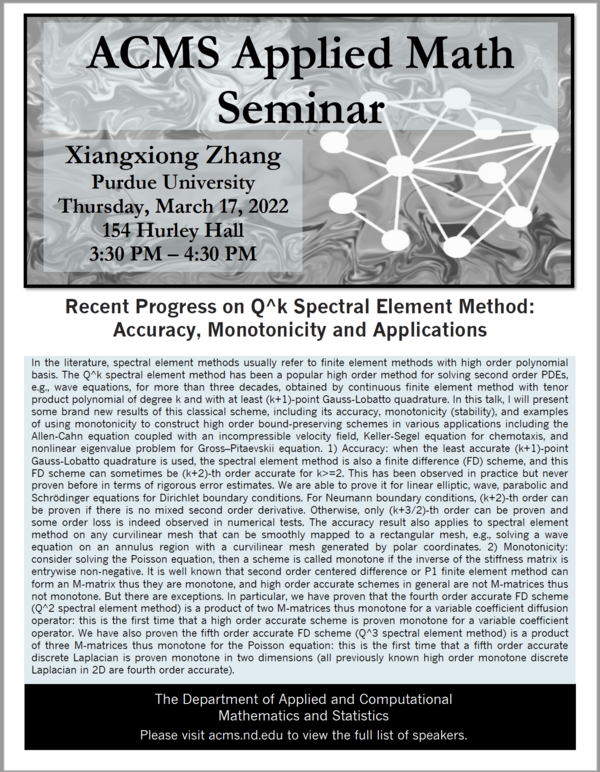Xiangxiong Zhang
Purdue University
Thursday, March 17, 2022
3:30 pm - 4:30 pm
154 Hurley Hall
Title: Recent Progress on Q^k Spectral Element Method: Accuracy, Monotonicity and Applications
Abstract:
In the literature, spectral element methods usually refer to finite element methods with high order polynomial basis. The Q^k spectral element method has been a popular high order method for solving second order PDEs, e.g., wave equations, for more than three decades, obtained by continuous finite element method with tenor product polynomial of degree k and with at least (k+1)-point Gauss-Lobatto quadrature. In this talk, I will present some brand new results of this classical scheme, including its accuracy, monotonicity (stability), and examples of using monotonicity to construct high order bound-preserving schemes in various applications including the Allen-Cahn equation coupled with an incompressible velocity field, Keller-Segel equation for chemotaxis, and nonlinear eigenvalue problem for Gross–Pitaevskii equation. 1) Accuracy: when the least accurate (k+1)-point Gauss-Lobatto quadrature is used, the spectral element method is also a finite difference (FD) scheme, and this FD scheme can sometimes be (k+2)-th order accurate for k>=2. This has been observed in practice but never proven before in terms of rigorous error estimates. We are able to prove it for linear elliptic, wave, parabolic and Schrödinger equations for Dirichlet boundary conditions. For Neumann boundary conditions, (k+2)-th order can be proven if there is no mixed second order derivative. Otherwise, only (k+3/2)-th order can be proven and some order loss is indeed observed in numerical tests. The accuracy result also applies to spectral element method on any curvilinear mesh that can be smoothly mapped to a rectangular mesh, e.g., solving a wave equation on an annulus region with a curvilinear mesh generated by polar coordinates. 2) Monotonicity: consider solving the Poisson equation, then a scheme is called monotone if the inverse of the stiffness matrix is entrywise non-negative. It is well known that second order centered difference or P1 finite element method can form an M-matrix thus they are monotone, and high order accurate schemes in general are not M-matrices thus not monotone. But there are exceptions. In particular, we have proven that the fourth order accurate FD scheme (Q^2 spectral element method) is a product of two M-matrices thus monotone for a variable coefficient diffusion operator: this is the first time that a high order accurate scheme is proven monotone for a variable coefficient operator. We have also proven the fifth order accurate FD scheme (Q^3 spectral element method) is a product of three M-matrices thus monotone for the Poisson equation: this is the first time that a fifth order accurate discrete Laplacian is proven monotone in two dimensions (all previously known high order monotone discrete Laplacian in 2D are fourth order accurate).
